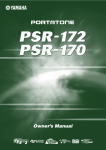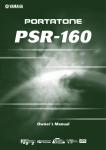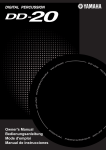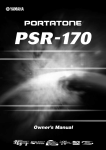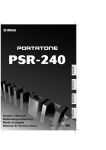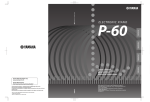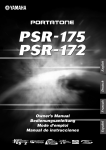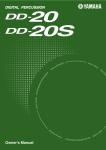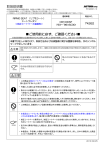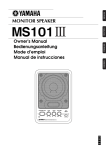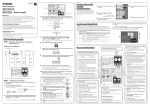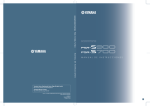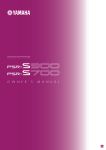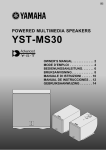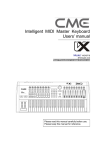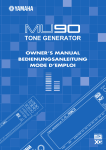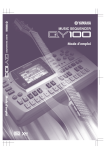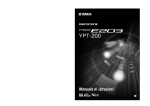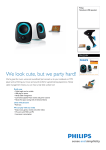Download Yamaha psr-262 Owner's Manual
Transcript
SPECIAL MESSAGE SECTION This product utilizes batteries or an external power supply (adapter). DO NOT connect this product to any power supply or adapter other than one described in the manual, on the name plate, or specifically recommended by Yamaha. This product may also use “household” type batteries. Some of these may be rechargeable. Make sure that the battery being charged is a rechargeable type and that the charger is intended for the battery being charged. This product should be used only with the components supplied or; a cart, rack, or stand that is recommended by Yamaha. If a cart, etc., is used, please observe all safety markings and instructions that accompany the accessory product. When installing batteries, do not mix batteries with new, or with batteries of a different type. Batteries MUST be installed correctly. Mismatches or incorrect installation may result in overheating and battery case rupture. SPECIFICATIONS SUBJECT TO CHANGE: Do not attempt to disassemble, or incinerate any battery. Keep all batteries away from children. Dispose of used batteries promptly and as regulated by the laws in your area. Note: Check with any retailer of household type batteries in your area for battery disposal information. The information contained in this manual is believed to be correct at the time of printing. However, Yamaha reserves the right to change or modify any of the specifications without notice or obligation to update existing units. This product, either alone or in combination with an amplifier and headphones or speaker/s, may be capable of producing sound levels that could cause permanent hearing loss. DO NOT operate for long periods of time at a high volume level or at a level that is uncomfortable. If you experience any hearing loss or ringing in the ears, you should consult an audiologist. IMPORTANT: The louder the sound, the shorter the time period before damage occurs. Disposal Notice: Should this product become damaged beyond repair, or for some reason its useful life is considered to be at an end, please observe all local, state, and federal regulations that relate to the disposal of products that contain lead, batteries, plastics, etc. If your dealer is unable to assist you, please contact Yamaha directly. NAME PLATE LOCATION: NOTICE: Service charges incurred due to a lack of knowledge relating to how a function or effect works (when the unit is operating as designed) are not covered by the manufacturer’s warranty, and are therefore the owners responsibility. Please study this manual carefully and consult your dealer before requesting service. ENVIRONMENTAL ISSUES: Yamaha strives to produce products that are both user safe and environmentally friendly. We sincerely believe that our products and the production methods used to produce them, meet these goals. In keeping with both the letter and the spirit of the law, we want you to be aware of the following: Battery Notice: This product MAY contain a small non-rechargeable battery which (if applicable) is soldered in place. The average life span of this type of battery is approximately five years. When replacement becomes necessary, contact a qualified service representative to perform the replacement. 92-BP (bottom) Warning: The name plate is located on the bottom of the product. The model number, serial number, power requirements, etc., are located on this plate. You should record the model number, serial number, and the date of purchase in the spaces provided below and retain this manual as a permanent record of your purchase. Model Serial No. Purchase Date PLEASE KEEP THIS MANUAL FCC INFORMATION (U.S.A.) 1. IMPORTANT NOTICE: DO NOT MODIFY THIS UNIT! This product, when installed as indicated in the instructions contained in this manual, meets FCC requirements. Modifications not expressly approved by Yamaha may void your authority, granted by the FCC, to use the product. 2. IMPORTANT: When connecting this product to accessories and/or another product use only high quality shielded cables. Cable/s supplied with this product MUST be used. Follow all installation instructions. Failure to follow instructions could void your FCC authorization to use this product in the USA. 3. NOTE: This product has been tested and found to comply with the requirements listed in FCC Regulations, Part 15 for Class “B” digital devices. Compliance with these requirements provides a reasonable level of assurance that your use of this product in a residential environment will not result in harmful interference with other electronic devices. This equipment generates/uses radio frequencies and, if not installed and used according to the instructions found in the users manual, may cause interference harmful to the operation of other electronic devices. Compliance * This applies only to products distributed by YAMAHA CORPORATION OF AMERICA. Relocate either this product or the device that is being affected by the interference. Utilize power outlets that are on different branch (circuit breaker or fuse) circuits or install AC line filter/s. In the case of radio or TV interference, relocate/reorient the antenna. If the antenna lead-in is 300 ohm ribbon lead, change the lead-in to co-axial type cable. If these corrective measures do not produce satisfactory results, please contact the local retailer authorized to distribute this type of product. If you can not locate the appropriate retailer, please contact Yamaha Corporation of America, Electronic Service Division, 6600 Orangethorpe Ave, Buena Park, CA90620 The above statements apply ONLY to those products distributed by Yamaha Corporation of America or its subsidiaries. (class B) OBSERVERA! Entsorgung leerer Batterien (nur innerhalb Deutschlands) Apparaten kopplas inte ur växelströmskällan (nätet) sá länge som den ar ansluten till vägguttaget, även om själva apparaten har stängts av. Leisten Sie einen Beitrag zum Umweltschutz. Verbrauchte Batterien oder Akkumulatoren dürfen nicht in den Hausmüll. Sie können bei einer Sammelstelle für Altbatterien bzw. Sondermüll abgegeben werden. Informieren Sie sich bei Ihrer Kommune. ADVARSEL: Netspæendingen til dette apparat er IKKE afbrudt, sálæenge netledningen siddr i en stikkontakt, som er t endt — ogsá selvom der or slukket pá apparatets afbryder. VAROITUS: Laitteen toisiopiiriin kytketty käyttökytkin ei irroita koko laitetta verkosta. (standby) 2 with FCC regulations does not guarantee that interference will not occur in all installations. If this product is found to be the source of interference, which can be determined by turning the unit “OFF” and “ON”, please try to eliminate the problem by using one of the following measures: (battery) PRECAUTIONS PLEASE READ CAREFULLY BEFORE PROCEEDING * Please keep these precautions in a safe place for future reference. WARNING Always follow the basic precautions listed below to avoid the possibility of serious injury or even death from electrical shock, short-circuiting, damages, fire or other hazards. These precautions include, but are not limited to, the following: • Do not open the instrument or attempt to disassemble the internal parts or modify them in any way. The instrument contains no user-serviceable parts. If it should appear to be malfunctioning, discontinue use immediately and have it inspected by qualified Yamaha service personnel. • Do not expose the instrument to rain, use it near water or in damp or wet conditions, or place containers on it containing liquids which might spill into any openings. • If the AC adaptor cord or plug becomes frayed or damaged, or if there is a sudden loss of sound during use of the instrument, or if any unusual smells or smoke should appear to be caused by it, immediately turn off the power switch, disconnect the adaptor plug from the outlet, and have the instrument inspected by qualified Yamaha service personnel. • Use the specified adaptor (PA-3B or an equivalent recommended by Yamaha) only. Using the wrong adaptor can result in damage to the instrument or overheating. • Before cleaning the instrument, always remove the electric plug from the outlet. Never insert or remove an electric plug with wet hands. • Check the electric plug periodically and remove any dirt or dust which may have accumulated on it. CAUTION Always follow the basic precautions listed below to avoid the possibility of physical injury to you or others, or damage to the instrument or other property. These precautions include, but are not limited to, the following: • Do not place the AC adaptor cord near heat sources such as heaters or radiators, and do not excessively bend or otherwise damage the cord, place heavy objects on it, or place it in a position where anyone could walk on, trip over, or roll anything over it. • When removing the electric plug from the instrument or an outlet, always hold the plug itself and not the cord. • Do not connect the instrument to an electrical outlet using a multiple-connector. Doing so can result in lower sound quality, or possibly cause overheating in the outlet. • Unplug the AC power adaptor when not using the instrument, or during electrical storms. • Always make sure all batteries are inserted in conformity with the +/polarity markings. Failure to do so might result in overheating, fire, or battery fluid leakage. • Always replace all batteries at the same time. Do not use new batteries together with old ones. Also, do not mix battery types, such as alkaline batteries with manganese batteries, or batteries from different makers, or different types of batteries from the same maker, since this can cause overheating, fire, or battery fluid leakage. • Do not dispose of batteries in fire. • Do not attempt to recharge batteries that are not intended to be charged. • When the batteries run out, or if the instrument is not to be used for a long time, remove the batteries from the instrument to prevent possible leakage of the battery fluid. • Keep batteries away from children. • If the batteries do leak, avoid contact with the leaked fluid. If the battery fluid should come in contact with your eyes, mouth, or skin, wash immediately with water and consult a doctor. Battery fluid is corrosive and may possibly cause loss of sight or chemical burns. • Before connecting the instrument to other electronic components, turn off the power for all components. Before turning the power on or off for all components, set all volume levels to minimum. Also, be sure to set the volumes of all components at their minimum levels and gradually raise the volume controls while playing the instrument to set the desired listening level. day) to prevent the possibility of panel disfiguration or damage to the internal components. • Do not use the instrument near other electrical products such as televisions, radios, or speakers, since this might cause interference which can affect proper operation of the other products. • Do not place the instrument in an unstable position where it might accidentally fall over. • Before moving the instrument, remove all connected adaptor and other cables. • When cleaning the instrument, use a soft, dry cloth. Do not use paint thinners, solvents, cleaning fluids, or chemical-impregnated wiping cloths. Also, do not place vinyl, plastic or rubber objects on the instrument, since this might discolor the panel or keyboard. • Do not rest your weight on, or place heavy objects on the instrument, and do not use excessive force on the buttons, switches or connectors. • Use only the stand specified for the instrument. When attaching the stand or rack, use the provided screws only. Failure to do so could cause damage to the internal components or result in the instrument falling over. • Do not operate the instrument for a long period of time at a high or uncomfortable volume level, since this can cause permanent hearing loss. If you experience any hearing loss or ringing in the ears, consult a physician. ■SAVING USER DATA • Always save data to an external device such as the Yamaha MIDI data filer MDF3 frequently, in order to help prevent the loss of important data due to a malfunction or user operating error. Yamaha cannot be held responsible for damage caused by improper use or modifications to the instrument, or data that is lost or destroyed. Always turn the power off when the instrument is not in use. Make sure to discard used batteries according to local regulations. * The illustrations and LCD screens as shown in this owner’s manual are for instructional purposes only, and may be different from the ones on your instrument. • Do not expose the instrument to excessive dust or vibrations, or extreme cold or heat (such as in direct sunlight, near a heater, or in a car during the (4)-7 3 Congratulations on your purchase of the Yamaha PSR-262 PortaTone! You now own a portable keyboard that combines advanced functions, great sound and exceptional ease-of-use in a highly compact package. Its outstanding features also make it a remarkably expressive and versatile instrument. Read this Owner’s Manual carefully while playing your new PSR-262 in order to take full advantage of its various features. Main Features The PSR-262 is a sophisticated yet easy-to-use keyboard with the following features and functions: ■ Yamaha Education Suite The PSR-262 features the new Yamaha Education Suite — a set of learning tools that utilize the latest technology to make studying and practicing music more fun and fulfilling than ever before! The Yamaha Education Suite includes: ● Lesson ............................. page 34 The convenient and easy-to-use Lesson feature, guides you through the parts of a song — just like a patient teacher! Select from any one of 100 songs on the PSR-262, and learn the left- and right-hand parts independently at first, then together. Lesson features four easy steps that help you master each song: Timing, Waiting, Minus One, and Both Hands. ● Grade & Talking ............................. pages 39, 40 The PSR-262 also has the Grade and Talking features. Grade is a virtual “teacher,” evaluating your practice sessions and rating your performance. The convenient Talking function “announces” each Lesson step and your “grades,” among other things. ● Dictionary ............................. page 41 Dictionary is a built-in “chord encyclopedia” that teaches you how to play specific chords by showing you the appropriate notes in the display — perfect for when you know the name of a chord and want to quickly learn how to play it! ■ Portable Grand ............................. page 20 The PSR-262 also has a Portable Grand function for realistic piano performance. Pressing the [Piano] button instantly calls up the stunningly authentic “Stereo Sampled Piano” voice and configures the entire PSR-262 for optimum piano play. Special Pianist styles — with piano-only accompaniment — are also provided. ■ DJ ............................. page 22 The DJ feature is an exciting new addition to the PSR-262, that puts a wealth of contemporary sounds and rhythms at your fingertips. Pressing the [DJ] button instantly calls up one of the special DJ songs (“DJ GAME”) and a DJ style, and provides the appropriate voice and sound effects to match. Other powerful features include: • Exceptionally realistic and dynamic sounds with 100 voices, utilizing digital recordings of actual instruments. • Convenient control over accompaniment Styles — including Tempo, Tap Tempo and independent Accompaniment Volume. • Touch Response lets you dynamically and expressively control the volume of the voices with your playing strength — just as on an acoustic piano. • Four Multi Pads, for instantly adding special instrumental breaks, fills, and phrases to your performance. • 100 dynamic auto accompaniment Styles, each with different Intro, Main A and B, and Ending sections. All styles (except for the Piano styles) also have their own two Fill-in patterns. • Large custom LCD gives you easy, at-a-glance confirmation of all important settings, as well as chord and note indications. • 100 songs, for your listening enjoyment — or for use with the sophisticated learning tools of the Yamaha Education Suite. 4 • One Touch Setting (OTS), for automatically calling up an appropriate voice for playing with the selected Style and Song. • MIDI terminals for interfacing with other MIDI devices. • The PSR-262 also has a Sustain jack. • Built-in, high-quality stereo amplifier/speaker system. Contents Panel Controls and Terminals ........................ 6 Talking ............................................................ 40 Setting Up......................................................... 8 Dictionary ....................................................... 41 • Power Requirements ..........................................8 • Turning On the Power.........................................8 • Accessory Jacks .................................................9 Selecting and Playing Styles........................ 42 Quick Guide Step 1 Step 2 Step 3 Step 4 10 Voices ........................................................... 10 Songs............................................................ 12 Auto Accompaniment ..................................... 14 Lesson .......................................................... 16 • Selecting and Playing a Style .......................... 42 • Playing the Accompaniment ............................ 43 • Changing the Tempo ....................................... 46 • Style Sections (Main A, Main B) and Fill-ins .... 46 • Adjusting the Accompaniment Volume ............ 47 • Using Auto Accompaniment — Multi Fingering............................................. 48 • Multi Pads ........................................................ 51 MIDI ................................................................. 52 Troubleshooting ............................................ 53 Getting Started — Playing the Demo Songs .......................... 18 Panel Display Indications ............................. 19 Portable Grand............................................... 20 Voice List ....................................................... 54 Drum Kit List .................................................. 56 Style List & Multi pads .................................. 57 • Playing the Portable Grand...............................20 • Using the Metronome .......................................20 MIDI Implementation Chart ........................... 58 DJ .................................................................... 22 Index ............................................................... 61 Specifications ................................................ 60 • Playing the DJ...................................................22 Selecting and Playing Voices ....................... 23 • Selecting and Playing a Voice ..........................23 • One Touch Setting............................................26 • Transpose and Tuning......................................27 • Touch Response...............................................28 Selecting and Playing Songs........................ 29 • Selecting and Playing a Song...........................29 • Melody Voice Change.......................................30 • Changing the Tempo ........................................31 • Adjusting the Song Volume ..............................32 • Song Controls ...................................................32 • A-B Repeat .......................................................33 Song Lesson .................................................. 34 • Using the Lesson Feature.................................34 • Lesson 1 — Timing...........................................36 • Lesson 2 — Waiting..........................................37 • Lesson 3 — Minus One ....................................37 • Lesson 4 — Both Hands...................................38 • Grade................................................................39 5 Panel Controls and Terminals ■ Front Panel q e !1 u y r 000 o GrandPno TEMPO w 116 t !8 !9 @0 i !0 !7 !2 !3 !4 !5 !6 q Power switch ([STANDBY/ON]) w [MASTER VOLUME] dial This determines the overall volume of the PSR-262. e [TOUCH] button This turns the Touch Response function on and off. It also lets you set the Touch Sensitivity setting. (See page 28.) r [Dict.] (DICTIONARY) button This calls up the Dictionary function (See page 41). t LESSON [L] (Left) and [R] (Right) buttons These call up the Lesson exercises for the corresponding hand (left or right) for the selected song. (See page 35.) y [OVERALL] button This is for selecting the various “overall” functions. (See page 21.) u [DEMO] button This is used to play the Demo songs. (See page 18.) i [Piano] button This instantly calls up the Grand Piano voice, plus a special piano song and style. (See page 20.) o [METRONOME] button This turns the metronome on and off. (See page 20.) 6 @1 !0 [DJ] button This instantly calls up a special DJ voice, song and style. (See page 22.) !1 Numeric keypad, [+/ON] and [-/OFF] buttons These are used for selecting songs, voices, and styles. (See page 24.) They are also used for entering values and adjusting or making certain settings. !2 [ACCOMPANIMENT ON/OFF] ([A-B REPEAT]) button When the Style mode is selected, this turns the auto accompaniment on and off. (See page 43.) When the Song mode is selected, this controls the A-B Repeat function. (See page 33.) !3 [SYNC START] ([ PAUSE]) button When the Style mode is selected, this turns the Sync Start function on and off. (See page 44.) When the Song mode is selected, this alternately pauses and starts song playback. (See page 32.) !4 [START/STOP] button When the Style mode is selected, this alternately starts and stops the auto accompaniment. (See page 43.) When the Song mode is selected, this alternately starts and stops song playback. (See page 32.) Panel Controls and Terminals !5 [INTRO/ENDING] ([ REW]) button When the Style mode is selected, this is used to control the Intro and Ending functions. (See page 45.) When the Song mode is selected, this is used to rewind during song playback. When song playback is stopped, it is used to reverse to specific measure numbers in the song. (See page 32.) !6 [MAIN/AUTO FILL] ([ FF]) button When the Style mode is selected, this is used to change auto accompaniment sections and control the Auto Fill function. (See page 46.) When the Song mode is selected, this is used to fast forward during song playback. When song playback is stopped, it is used to advance to specific measure numbers in the song. (See page 32.) !8 [SONG] button This is for enabling song selection. (See page 29.) !9 [STYLE] button This is for enabling style selection. (See page 42.) @0 [VOICE] button This is for enabling voice selection. (See page 23.) Holding down this button calls up the Melody Voice Change function. (See page 30.) @1 [MULTI PAD] buttons These are used to automatically play pre-programmed musical phrases. (See page 51.) !7 [TEMPO/TAP] button This button allows you to tap out the tempo and automatically start a selected song or style at that tapped speed. (See page 44.) It also is used to call up the Tempo setting, letting you set the Tempo with the numeric keypad or [+]/[-] buttons. (See page 31.) ■ Rear Panel @2 @3 @4 @5 @2 PHONES/OUTPUT jack This is for connection to a set of stereo headphones or to an external amplifier/speaker system. (See page 9.) @3 DC IN 10-12V jack This is for connection to a PA-3B AC power adaptor. (See page 8.) @4 MIDI IN, OUT terminals These are for connection to other MIDI instruments and devices. (See pages 9, 52.) @5 SUSTAIN jack This is for connection to an optional FC4 or FC5 Footswitch. (See page 9.) 7 Setting Up This section contains information about setting up your PSR-262 for playing. Make sure to read this section carefully before using the instrument. Power Requirements Although the PSR-262 will run either from an optional AC adaptor or batteries, Yamaha recommends use of an AC adaptor whenever possible. An AC adaptor is more environmentally friendly than batteries and does not deplete resources. ■ Using an AC Power Adaptor • • • • • • • • • • • • • • • • • • • • • • • • • To connect your PSR-262 to a wall socket, you will need the optionally available Yamaha PA-3B Power Adaptor. Use of other AC adaptors could result in damage to the instrument, so be sure to ask for the right kind. Connect one end of the adaptor to the DC IN 10-12V jack on the rear panel of your PSR-262, and the other end to a suitable electrical outlet. • Use ONLY a Yamaha PA-3B AC Power Adaptor (or other adaptor specifically recommended by Yamaha) to power your instrument from the AC mains. The use of other adaptors may result in irreparable damage to both the adaptor and the PSR262. • Unplug the AC Power Adaptor when not using the PSR-262, or during electrical storms. ■ Using Batteries • • • • • • • • • • • • • • • • • • • • • • • • • • • • • • • • • • ● Inserting Batteries Turn the instrument upside-down and remove the battery compartment lid. Insert six 1.5-volt size “D” (SUM-1, R-20 or equivalent) batteries as shown in the illustration, making sure that the positive and negative terminals are properly aligned, and replace the lid. • Never mix old and new batteries or different types of batteries (e.g., alkaline and manganese). • To prevent possible damage from battery leakage, remove the batteries from the instrument if it is not to be used for a long time. BATTERIES 1.5V x 6 ● When the Batteries Run Down When the batteries run low and the battery voltage drops below a certain level, the PSR-262 may not sound or function properly. As soon as this happens, replace them with a complete set of six new batteries. Turning On the Power With the AC power adaptor connected or with batteries installed, simply press the STANDBY switch until it locks in the ON position. When the instrument is not in use, be sure to turn the power off. (Press the switch again so that it pops up.) 8 • Even when the switch is in the “STANDBY” position, electricity is still flowing to the instrument at the minimum level. When you are not using the PSR-262 for a long time, make sure you unplug the AC power adaptor from the wall AC outlet, and/or remove the batteries from the instrument. Setting Up Accessory Jacks ■ Using Headphones• • • • • • • • • • • • • • • • • • • • • • • • • • • • • • • • For private practicing and playing without disturbing others, connect a set of stereo headphones to the rear panel PHONES/OUTPUT jack. Sound from the builtin speaker system is automatically cut off when you insert a headphone plug into this jack. ■ Connecting a Keyboard Amplifier or Stereo System • • • • • • • Though the PSR-262 is equipped with a built-in speaker system, you can also play it through an external amplifier/speaker system. First, make sure the PSR-262 and any external devices are turned off, then connect one end of a stereo audio cable to the LINE IN or AUX IN jack(s) of the other device and the other end to the rear panel PHONES/OUTPUT jack on the PSR-262. • To prevent damage to the speakers, set the volume of the external devices at the minimum setting before connecting them. Failure to observe these cautions may result in electric shock or equipment damage. Also, be sure to set the volumes of all devices at their minimum levels and gradually raise the volume controls while playing the instrument to set the desired listening level. ■ Using a Sustain Footswitch • • • • • • • • • • • • • • • • • • • • • • • • • This feature lets you use an optional footswitch (Yamaha FC4 or FC5) to sustain the sound of the keyboard voice. This is used in the same way as a damper pedal on an acoustic piano — press and hold down the footswitch as you play the keyboard to sustain the sound. ■ Using the MIDI Terminals • • • • • • • • • • • • • • • • • • • • • • • • • • • • Make sure that the footswitch plug is properly connected to the SUSTAIN jack before turning on the power. • Do not press the footswitch while turning the power on. Doing this changes the recognized polarity of the footswitch, resulting in reversed footswitch operation. MIDI instrument The PSR-262 also features MIDI terminals, allowing you to interface the PSR262 with other MIDI instruments and devices. (For more information, see page 52.) Music Stand Insert the bottom edge of the included music stand into the slot located at the top rear of the PSR-262 control panel. 9 Quick Guide Step 1 Voices w w z 000 GrandPno TEMPO 116 q z q Playing the Piano Simply by pressing the [Piano] button, you can automatically reset the entire PSR-262 for piano play. z Press the [Piano] button. Playing along with the Metronome z Press the [METRONOME] button. 000 GrandPno x Play the keyboard. Want to find out more? See page 21. Want to find out more? See page 20. ● Panel Voice List No. 001 002 003 004 005 006 007 008 009 010 10 Voice Name PIANO GRAND PIANO HONKY-TONK E PIANO 1 E PIANO 2 E PIANO 3 E PIANO 4 HARPSICHORD CLAVI CELESTA ORGAN VIBRATO OFF Voice Name VIBRATO ON HARMONY OFF HARMONY ON ATTACK OFF ATTACK ON WAVE OFF WAVE ON PIPE ORGAN ACCORDION HARMONICA GUITAR/BASS 021 SOFT GUITAR No. 011 012 013 014 015 016 017 018 019 020 No. Voice Name 022 FOLK GUITAR 023 12ST GUITAR 024 JAZZ GUITAR 025 E GUITAR 026 DIST GUITAR 027 WOOD BASS 028 FINGER BASS 029 SLAP BASS STRINGS/MALLET 030 STRINGS 031 VIOLIN 032 CELLO No. 033 034 035 036 037 038 039 040 041 042 043 Voice Name HARP SITAR BANJO VIBRAPHONE MARIMBA STEEL DRUMS WIND TRUMPET TROMBONE MUTE TRPET FRENCH HORN BRASS SECT No. 044 045 046 047 048 049 050 051 052 053 054 Voice Name ALTO SAX TENOR SAX OBOE CLARINET FLUTE PAN FLUTE SYNTHESIZER THICK LEAD SIMPLE LEAD THICK SAW SIMPLE SAW SYNTH BASS Step 1 Voices Selecting and Playing Other Voices The PSR-262 has a total of 100 dynamic and realistic instrument voices. Let’s try a few of them out now... q Press the [VOICE] button. w Select a voice. 002 000 HnkyTonk GrandPno TEMPO e Play the keyboard. 116 Want to find out more? See page 23. Playing with the DJ Feature The exciting new DJ feature gives you a full variety of dance and DJ sounds — letting you create your own real-time mixes and groove along with various contemporary rhythms. q Press the [DJ] button. e Play the DJ GAME voice. 098 DJvoice1 w Press the Lesson [L] or [R] button. No. 055 056 057 058 059 060 061 062 063 064 065 Voice Name SY STRINGS SY BRASS SLOW STRS CHORUS HARMONY PIANO TRIO PNO COUNTRY E PNO TRIO HARPSI TRIO E ORG TRIO VIBES DUET TRP DUET No. 066 067 068 069 070 071 072 073 074 075 Voice Name HORN DUET CLARINET TR FLUTE DUET SPLIT WD BASS/PNO STRINGS/PNO FN BA/E PNO HARP/VIOLIN HORN/TRP SUSTAIN SUS PIANO SUS E PNO1 Want to find out more? See page 22. No. 076 077 078 079 080 081 082 083 084 085 086 Voice Name SUS E PNO2 SUS VIBRAPHONE SUS STRINGS ECHO PIANO E PIANO HARPSICHORD CELESTA FOLK GUITAR BANJO VIBRAPHONE MARIMBA No. 087 088 089 090 091 092 093 094 095 096 097 Voice Name STEEL DRUMS DRUM KIT DUAL PNO CONCE E PNO CONCE FAIRY LAND MOOD GUITAR RICH GUITAR HOT ORGAN EXCEL VIOLIN CRYSTAL STAR SHIP No. 098 099 100 Voice Name DJ Voice DJ VOICE 1 DJ VOICE 2 DRUMS DRUM KIT 11 Quick Guide Step 2 Songs q zx 000 xw GrandPno TEMPO 116 xc z Playing the Songs The PSR-262 is packed with 100 songs, including 5 special Demo songs. Playing the Demo songs Demo songs (001 - 005) showcase the sophisticated features and stunning sound of the PSR-262. Let’s play the Demo songs now, starting with 001... Playing a single song Naturally, you can also individually select and play back any of the PSR-262’s songs (001 - 100). z Press the [SONG] button. z Press the [DEMO] button. 001 Livin'La 001 x Stop the Demo song. Livin'La x Select a song. or 002 Virtual c Start (and stop) the song. Want to find out more? See page 29. 12 Step 2 Songs ● Song List No. 001 002 003 004 005 006 007 008 009 010 011 012 Changing the vo
This document in other languages
- română: Yamaha psr-262
- français: Yamaha psr-262
- español: Yamaha psr-262
- Deutsch: Yamaha psr-262
- русский: Yamaha psr-262
- Nederlands: Yamaha psr-262
- dansk: Yamaha psr-262
- polski: Yamaha psr-262
- čeština: Yamaha psr-262
- svenska: Yamaha psr-262
- italiano: Yamaha psr-262
- português: Yamaha psr-262
- Türkçe: Yamaha psr-262
- suomi: Yamaha psr-262
































































